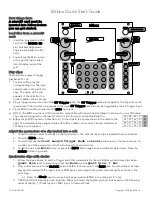
–
Mid reflections
: adjusts the amount of sound reflections happening in the
middle of the stereo field.
–
Doppler intensity
: the so called “Doppler” effect is the fundamental of the
“Leslie” effect that causes the sound to be cyclically untuned while the sound
source (the speaker) gets farther or nearer to the listened; this parameter lets
you adjust the amount of this effect that is mostly caused by the sound
reflections over the walls around the amplifier.
–
Dry Leak
: some of the dry sound coming from the speakers does not reach the
rotating elements and is mixed with the rotating sound. Use this parameter to
adjust the amount of dry signal you want to be mixed in.
–
Bass Port
: a real Leslie cabinet has a hole in the back that serves for two
reasons: 1) lets the heat from the motors ventilate out from the cabinet and 2)
acts as a bass tuning port, like those found on modern speakers. If you put a
microphone in front of this hole you get nothing but sub-bass frequencies. Use
this parameter to adjust the amount of sub-bass you want to get into the mix.
–
Tube feedback
. This is a very important parameter that works on an aspect of
the whole amplification system that can drastically vary both the dynamic
response and the frequency response, as well as have an impact on the
overdrive. When a Leslie cabinet is set very close to the Hammond organ and is
played at a high volume, there's some sort of feedback between the tubes, the
transformers and the pickups of the Hammond and the speakers of the Leslie,
resulting in a sound that tends to get “fatter”, the attack is “punchier” and the
distortion is aggressive, giving you the feeling that some sort of energy is
looping between the organ and its amplifier. Now, a genuine Leslie 122 or 147
is only 40W of power, but if you try to connect your Hammond organ to a 100W
guitar amp such as a Marshall JCM900 or a Fender Twin you'll notice that the
amp starts going in feedback even if you don't play any note on the organ. This
is... pure analog power! Try this parameter at small steps, it can drastically
change the sound in both a pleasant or unpleasant way, according to your
tastes.
–
Stop Position
: you can use this parameter to find a position where the horn
and rotor should “preferably” stop when you set the speed lever in the brake
position and the “Front Stop” option is enabled. Please consider that not always
the position you've set is reached with precision, it depends mostly on the
Ramp Down times you've set... after all it's virtual reality, baby! It takes into
account the kinetic energy, the gravity, the belt friction...
–
Noises
: well, a real rotary effect is far from being a quiet amplifier. Your
microphones will pick up not only the sound but also the wind generated by
the rotating elements, and the relays that switch between the fast and slow
motors. Use this parameter to adjust the amount of audible noises.
CRUMAR MOJO CLASSIC & SUITCASE USER'S MANUAL - Page 16/20


































